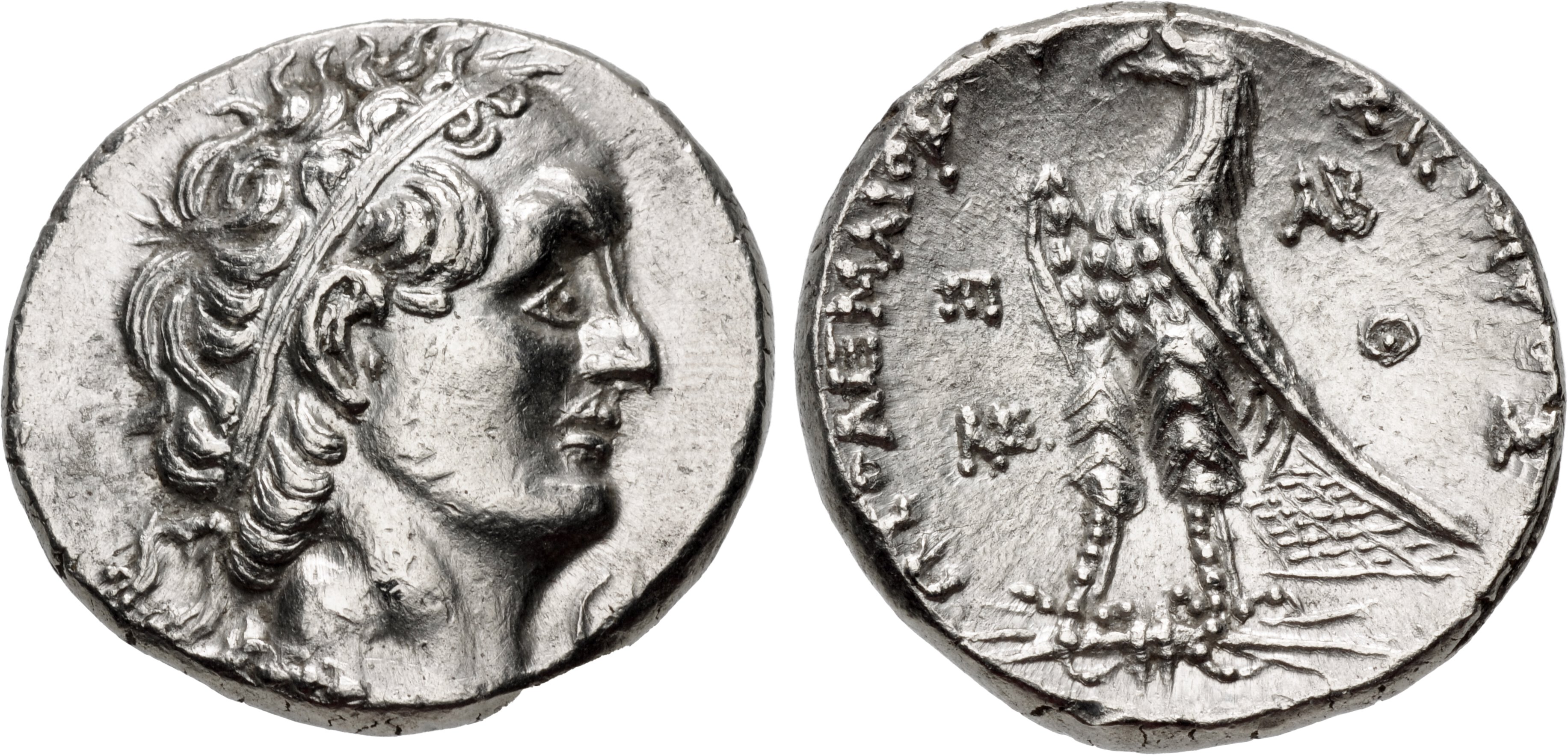Ptolemais-Ake? (Ptolemy II), silver, tetradrachms (256-246 BCE)
From SILVER
256 BCE - 246 BCE Silver 8,352 kg
Description
| ObverseInscription or printing placed on the obverse.: | Diademed head of Ptolemy I right, aegis around neck |
| ReverseInscription or printing placed on the reverse.: | BAΣΙΛΕΩΣ ΠΤΟΛΕΜΑΙΟΥ (Greek).Eagle with closed wings standing left on thunderbolt, to left, monogram above ΛΕ, to right, AB above Θ |
Mint and issuing power
| MintIdentifies the place of manufacture or issue of a numismatic object.: | Ptolemais-Ake | Ancient regionAncient region.: | Phoenicia | Modern countryModern country: Israel | AuthorityIdentifies the issuing power. The authority can be "pretended" when the name or the portrait of X is on the coin but he/she was not the issuing power. It can also be "uncertain" when there is no mention of X on the coin but he/she was the issuing power according to the historical sources: | Ptolemaic dynasty (323-30 BC), Ptolemy II Philadelphus (Ptolemaic king, 283-246 BC) |
Chronology
| FromIdentifies the initial date in a range assigned in a numismatic context. | 256 BCE | toIdentifies the final date in a range assigned in a numismatic context.. | 246 BCE | PeriodTime period of the numismatic object.: Hellenistic 323-30 BC |
Physical description
| MetalThe physical material (usually metal) from which an object is made.: | Silver |
Median weightMedian of the weights of numismatic objects (in grams). in grams | 14.20 | DenominationTerm indicating the value of a numismatic object. Examples: tetradrachm, chalkous, denarius.: | tetradrachm |
StandardStandard.: | Ptolemaic |
Image

S932 Ptolemais Ptolemy II.jpg [1]
References
| Die study referencePublication of the study: | Lorber 20131Lorber 2013 | ||
| Coin series referenceReference to coin series study: | CPE I2CPE I, n° 700 | ||
Obverse dies distribution
| FrequencyFrequency of specimen in distribution. ᵖ | Number of obversesNumber of obverse dies. ᵖ (o) | % (o) | Number of coinsNumber of coins. (n) | % (n) | Die nameName(s) of the die(s). |
| 1 | 10 | 58.82 | 10 | 31.25 | |
| 2 | 3 | 17.65 | 6 | 18.75 | |
| 3 | 2 | 11.76 | 6 | 18.75 | |
| 4 | 1 | 5.88 | 4 | 12.5 | |
| 6 | 1 | 5.88 | 6 | 18.75 | |
| Total | 17 of 17 | 99.99 | 32 of 32 | 100 |
Reverse dies distribution
no distribution is available
Quantification
| Number of obversesNumber of obverse dies. ᵖ (o) | 17 | Number of singletons (o1)The number of singleton coins. ᵖ | 10 |
| Number of reverse diesNumber of reverse dies. (r) | 28 | Number of coinsNumber of coins. (n) | 32 |
| Coins per obverse dieNumber of coins per obverse die. (n/o) | 1.88 | Coins per reverse dieNumber of coins per reverse die. (n/r) | 1.14 |
| Reverse per obverse ratioRatio of obverse dies divided by reverse dies. (r/o) | 1.65 | Percentage of singletons (o1)number of coins (n) divided by the number of singletons (o1) ᵖ | 58.82 % |
| Original number of dies (O) (Carter 1983 formula)The estimation of the number of coins according to Carter 1983 ᵖ | 29.41 | Coins struck if 20,000 as average productivity per dieCoins made if the average productivity for obverses (according to Carter) is 20,000. ᵖ | 588,200 |
| Original number of dies (O) (Esty 2011 formula)The estimation of the number of coins according to the singleton formula in Esty 2011 ᵖ (O) | 36.27 | Survival rate if 20,000 as average productivity per dieSurvival rate if average productivity is 20,000. ᵖ | 0.00005 |
| Coverage (o = % of O) (Esty 1984 formula)Esty 1984 - coverage (% of O) ᵖ (o = % of O) | 68.75% | Die productivity if survival rate 1/2,000Average productivity if survival rate is 1/2,000. ᵖ | 2,176.13 |
| Weight of silver (in kg) if 20,000 coins per die (O = Carter formula)Carter 1983 * Median weight * 20000 (*10 if gold or electrum) ᵖ | 8,352 kg <br /> 8,352 kg | Die productivity if survival rate 1/5,000Average productivity if survival rate is 1/5,000. ᵖ | 5,440.33 |
Remarks